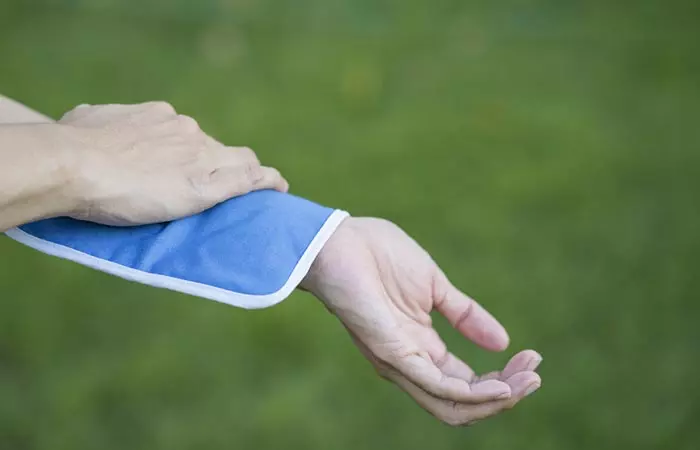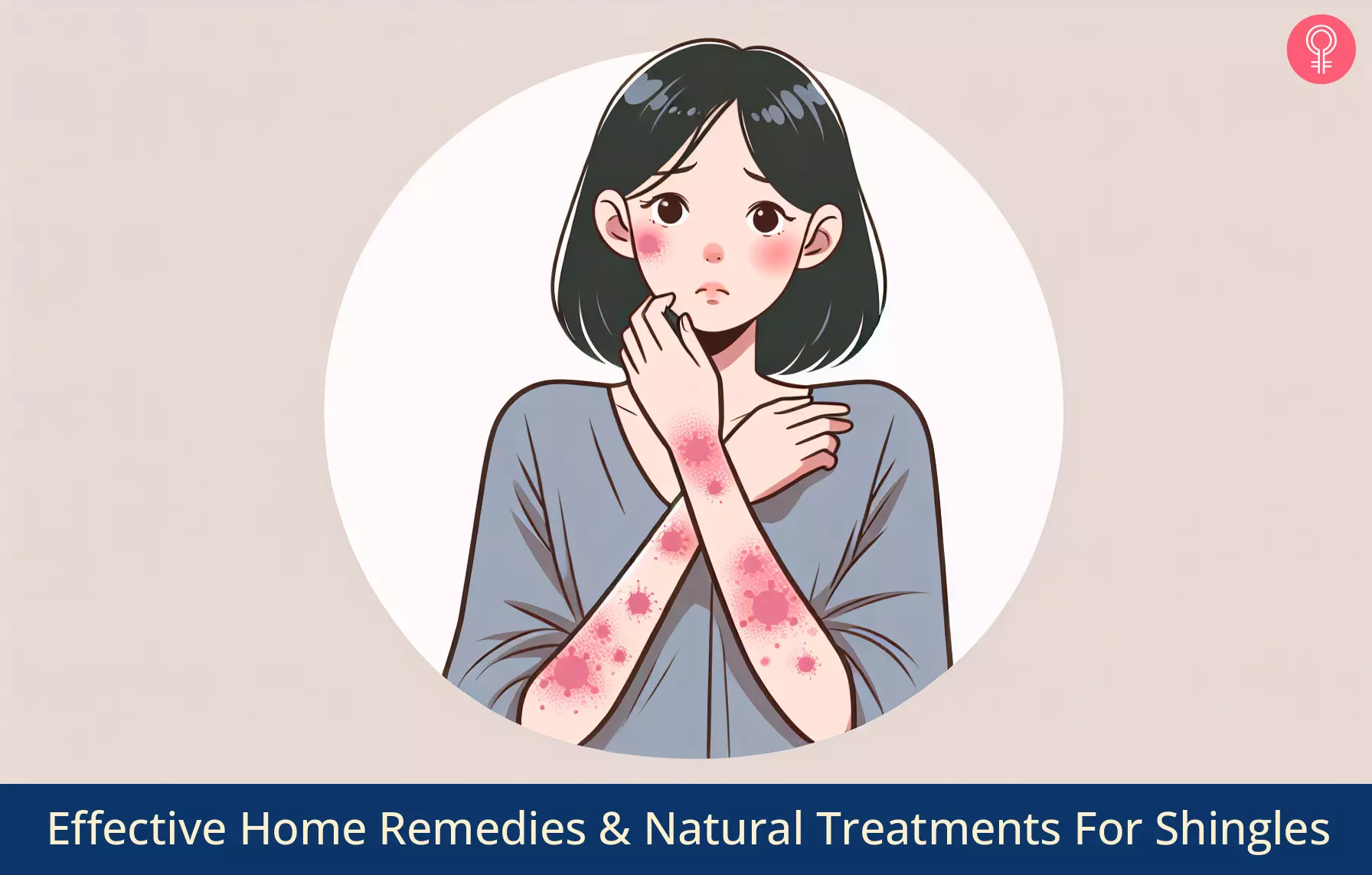Early diagnosis and effective treatment for shingles may help manage this infection. As per an estimate, one out of three persons in the US may develop shingles at least once in their life, and there are approximately a million cases diagnosed (1). If you have a history of chickenpox and observe any stubborn rashes or blisters, it is advised to get tested as there is a high chance that you have shingles. Read on to know more about shingles treatment.
What Is Shingles?
Shingles is an infection caused by the varicella-zoster virus. It is medically referred to as herpes zoster. This infection is the result of the same virus responsible for causing chickenpox. Shingles can cause painful rashes anywhere on the body. However, most often, it looks like a single stripe of blisters that wraps around one side of your body, typically on your neck, face, or torso. Shingles is characterized by a red skin rash that causes pain along with a burning sensation. In individuals who have had chicken pox earlier, the virus continues to remain dormant in the nerve tissues surrounding the spinal cord and brain. After many years, this inactive virus may get reactivated in the form of shingles. While shingles is not a life-threatening condition, it can turn out to be quite painful. However, early treatment reduces the risk of complications, and getting a vaccine can help reduce the risk of developing the infection. The available vaccination for shingles is approved for those 50 years or older. However, it is recommended that the vaccine is given at the age of 60, when the risk of developing shingles is the highest. In a study involving a multicenter clinical trial of Herpes Zoster Vaccines which enrolled >30,000 participants, it was found that the efficacy for the prevention of herpes zoster with the Recombinant Zoster Vaccine (RZV) was 96.6% (95% confidence interval [CI] = 89.6–99.3) in persons aged 50–59 years and for those aged 60–69 years it was 97.4% (95% CI = 90.1–99.7). Shingles progresses in three stages, more information about which is provided right below.
Stages And Symptoms
Shingles can be classified into three stages based on the progression and varying symptoms in each stage.
1st Stage – Prodromal Phase
The first stage, also referred to as the prodromal phase, is often characterized by symptoms like:
Headache Pain and burning sensation on one side of the body or in small patches all over the body Malaise or discomfort Photophobia
2nd Stage – Acute Phase
The second stage or acute phase is characterized by a dermatomal rash. The characteristics of the rash include:
Fluid-filled blisters that can break easily Red patches A rash that tends to wrap around one side of your torso The appearance of a rash on the face and ears
Such rashes are also accompanied by other symptoms like unbearable itching, fever, chills, headache, fatigue, and pain. These rashes last for 7-10 days, and most affected individuals heal in 4 weeks.
3rd Stage
The third stage of shingles is usually not experienced by all affected individuals. It is associated with complications like:
Rashes that involve the eyes Postherpetic neuralgia – A condition that can affect the nerve fibers and skin Loss of hearing, severe pain in one ear, dizziness, or loss of taste on your tongue that may be symptoms of Ramsay Hunt syndrome Subsequent bacterial infections
Erin Morrison, a photographer and blogger, recounted her struggle with shingles. In her blog, she explains, “My neck burned, and I had this quarter-sized knot in the back of the neck that was sore and hurt to touch. It was painful to stretch my neck or turn my head to the left. A couple of hours later, I was told that I had shingles (i).” As we have already mentioned before, shingles is caused by the varicella-zoster virus that is also responsible for causing chickenpox. Let us now look into the causes and risk factors for shingles.
Causes And Risk Factors For Shingles
Those with a history of chickenpox are at an increased risk of developing shingles. Once you recover from the former, the varicella-zoster virus that has already entered your nervous system continues to remain dormant there for years. Eventually, it can get reactivated and travel via your nerve pathways and reach the surface of your skin. This results in shingles. But, not all individuals who have had chickenpox will develop shingles. Some factors are associated with increasing your risk of developing shingles after having chickenpox. They include:
Age – Those over 50 years of age are at increased risk. Certain medical conditions like HIV/AIDS and cancer that weaken your immunity can also increase your risk of getting shingles. Undergoing cancer treatments Certain medications like steroids
It has been found that there is a sharp increase in the rate of medically-attended shingles cases in all age groups above the 45-49 group. It evaluates three different periods based on the availability of vaccines. The 1994-98 period denotes the pre-vaccine period, 1999-2001 denotes the time when the vaccine was only privately available, and 2002-2010 represents the period when it was publicly available. The graph below also shows how the rates of medically attended shingles were much lower in children aged less than 10 years for the publicly available period.
Age-specific Medically Attended Shingles Rate
Administration of vaccines is widely followed to reduce the chances of getting shingles. There is no cure for shingles, but your doctor may prescribe anti-inflammatory, antiviral, narcotic, and antihistamine medications to ease the symptoms and shorten the length of the infection. There are also some natural remedies available that can help in alleviating the symptoms of shingles and providing fast pain relief. Some of the best ones are discussed right below.
7 Effective Home Remedies For Shingles Relief
7 Natural Remedies To Manage Shingles
Though the home remedies for chickenpox and shingles may overlap, and they are caused by the same virus, you shouldn’t use these treatments interchangeably. Listed below are some remedies that can help you manage shingles.
1. Oatmeal Baths
1-2 cups of oatmeal Water
You can do this once daily. The antioxidant and anti-inflammatory properties of oatmeal can help soothe itchiness and inflammation in the affected area (2).
2. Cold/Hot Compress
A cold compress You may do this 1-2 times daily until the blisters stop oozing. Cold compresses do a wonderful job in reducing inflammation and swelling of the skin following an injury (3). Hence, they may also help in alleviating inflammation associated with shingles. Hot compresses may also help get rid of cold sores (4). They may, therefore, also be effective in treating the symptoms of shingles. Brian, a vlogger, tried hot heating pads for shingles relief. In his vlog, he explains, “I use heating pads and after that, I feel better (ii).”
3. Vitamins
Vitamins C and D can help in the treatment of shingles. While vitamin D has immunomodulatory activities, intravenous vitamin C can help alleviate pain and other symptoms associated with the infection (5), (6). Foods rich in these vitamins include citrus fruits, green leafy veggies, cheese, eggs, and fish. It is best to consult a doctor before going ahead with additional supplements for these vitamins.
4. Coconut Oil
1 tablespoon of virgin coconut oil Cotton balls
You may do this 1-2 times daily. The anti-inflammatory and analgesic properties of coconut oil can help in alleviating itching and pain that occur with shingles (7).
5. Garlic
4-5 garlic cloves Cotton pads
You can do this 1-2 times daily. The antiviral and anti-inflammatory nature of the garlic compounds can help in combating the symptoms of inflammation and pain while also fighting the virus responsible for triggering the infection (8), (9).
6. Tea Tree Oil
3 drops of tea tree oil 1-2 teaspoons of coconut oil Cotton balls
You can do this 1 or 2 times daily. Tea tree oil possesses impressive anti-inflammatory properties that can help reduce the itching and pain associated with shingles. Its antiviral nature can help speed up your recovery (10).
7. Honey
Honey, as needed A cotton pad/cotton ball
You can do this 1 to 2 times daily. Honey helps ease the discomfort and inflammation linked to shingles. Research suggests that honey’s antibacterial and antiviral properties serve as a protective barrier to the affected area. They help prevent infections and facilitate the healing process. Honey’s affordability, accessibility, and suitability for topical use makes it a promising option for managing shingles (11). Although these remedies can help alleviate discomfort from shingles, it is important to consult a healthcare provider if symptoms persist or if you experience severe pain. A healthcare professional can offer tailored advice and treatments to address your specific situation. There are also several homeopathic remedies serving as alternative medicines that may help in holistic healing. However, it is always best to prevent the infection. So, you may also follow the below tips to prevent the onset of shingles.
How To Prevent Shingles
Get yourself and your kids vaccinated for chickenpox if you have never had the disease. The vaccine may not necessarily prevent everyone from getting chickenpox, but it has been reported to be successful in 9 out of 10 individuals who took it. Adults in the age group of 50-60 years should take a vaccination for shingles. Besides getting vaccinated, supporting a healthy immune system with a balanced diet full of vitamins and minerals may help lower the risk of shingles.
As shingles are contagious, it is important that you take precautions to prevent the spreading of the infection to other individuals. Here’s what you need to do:
Keep your rash/blisters covered until they dry completely. Avoid contact with individuals who have never had chickenpox or have weak immunity. Avoid sharing of utensils. Wash your hands frequently.
Can you put hydrogen peroxide on shingles? Anecdotal evidence suggests that the application of hydrogen peroxide may reduce the itching caused by shingles. Can you spread shingles to other parts of your body? Yes, in rare cases, shingles may spread to other parts of the body, if the immune system support is weak (12). Can lack of sleep cause shingles? Yes, lack of sleep may weaken your immune system and increase your risk of developing shingles (13). Is yogurt good for shingles? Yes, probiotics like yogurt may strengthen the immune system and reduce the severity of viral infections (14). However, studies are limited and more research needs to be conducted to understand the link between the two. Therefore, it is best to be cautious while adding it to your skin care regimen to treat shingles.
Illustration: Effective Home Remedies & Natural Treatments For Shingles
Discover simple home remedies that may help treat shingles. Watch this video to understand the symptoms of this infection and how to find relief without medication.













